Case Study Analysis: Infectious Conjunctivitis in an Aged Care Setting
VerifiedAdded on 2022/12/28
|12
|2152
|78
Case Study
AI Summary
This case study examines an 88-year-old resident, John, in a high-dependency aged care facility who developed infectious conjunctivitis. The assignment explores the likely causative microorganisms, focusing on Staphylococcus aureus, and justifies the exclusion of others like Legionella pneumophila and Plasmodium ovale. It details the mechanism of action and adverse reactions of gentamicin, the prescribed treatment. Furthermore, it analyzes the physiological basis of observed signs like red-eye, mucopurulent secretion, and chemosis. The study identifies and discusses infection control issues in aged care facilities, such as hygiene and equipment sterilization. It then outlines the transmission of infection from John to another resident, Mary, and proposes procedures to break the chain of infection through proper hygiene and preventative measures. The assignment utilizes references to support the analysis and conclusions.
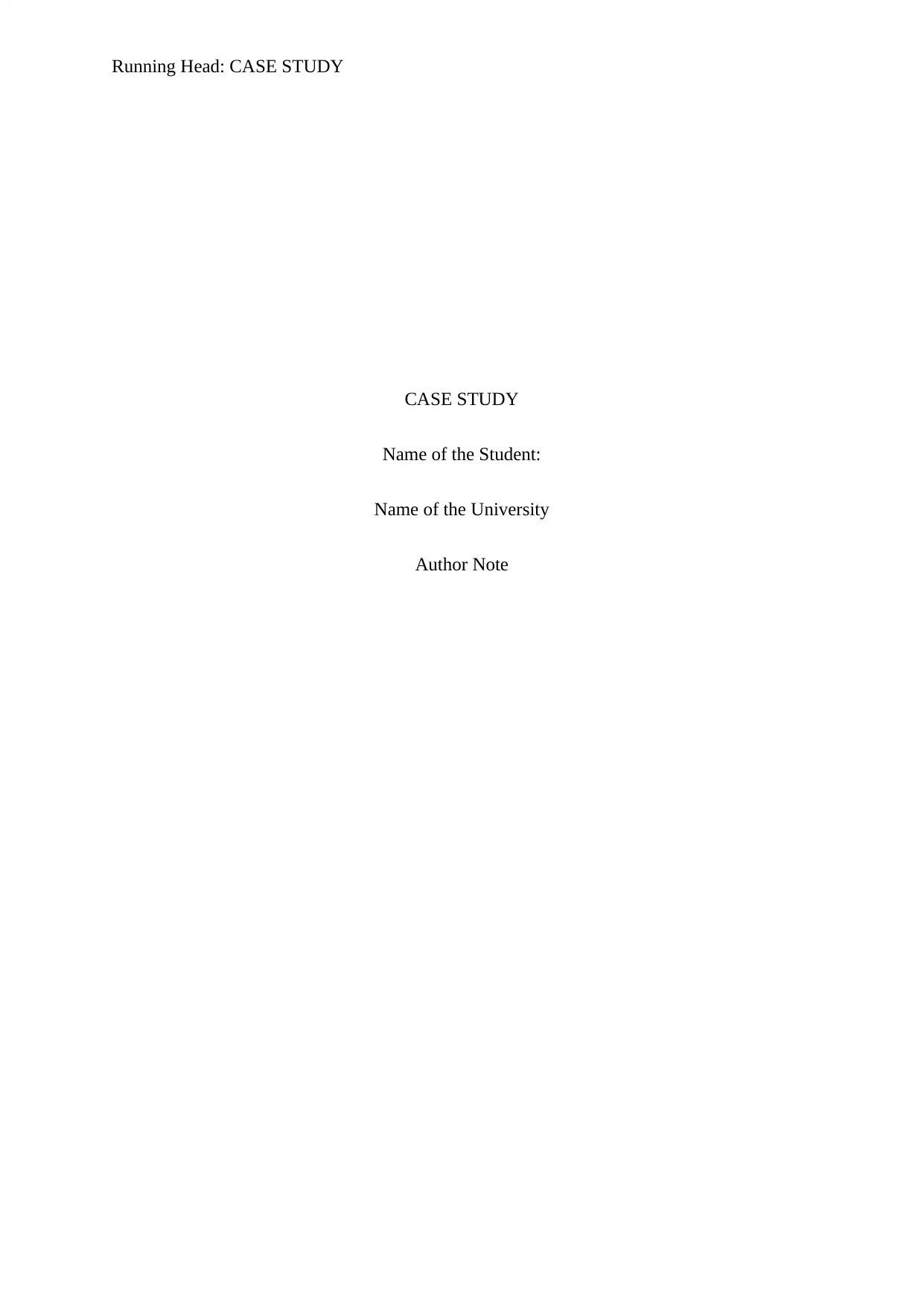
Running Head: CASE STUDY
CASE STUDY
Name of the Student:
Name of the University
Author Note
CASE STUDY
Name of the Student:
Name of the University
Author Note
Paraphrase This Document
Need a fresh take? Get an instant paraphrase of this document with our AI Paraphraser
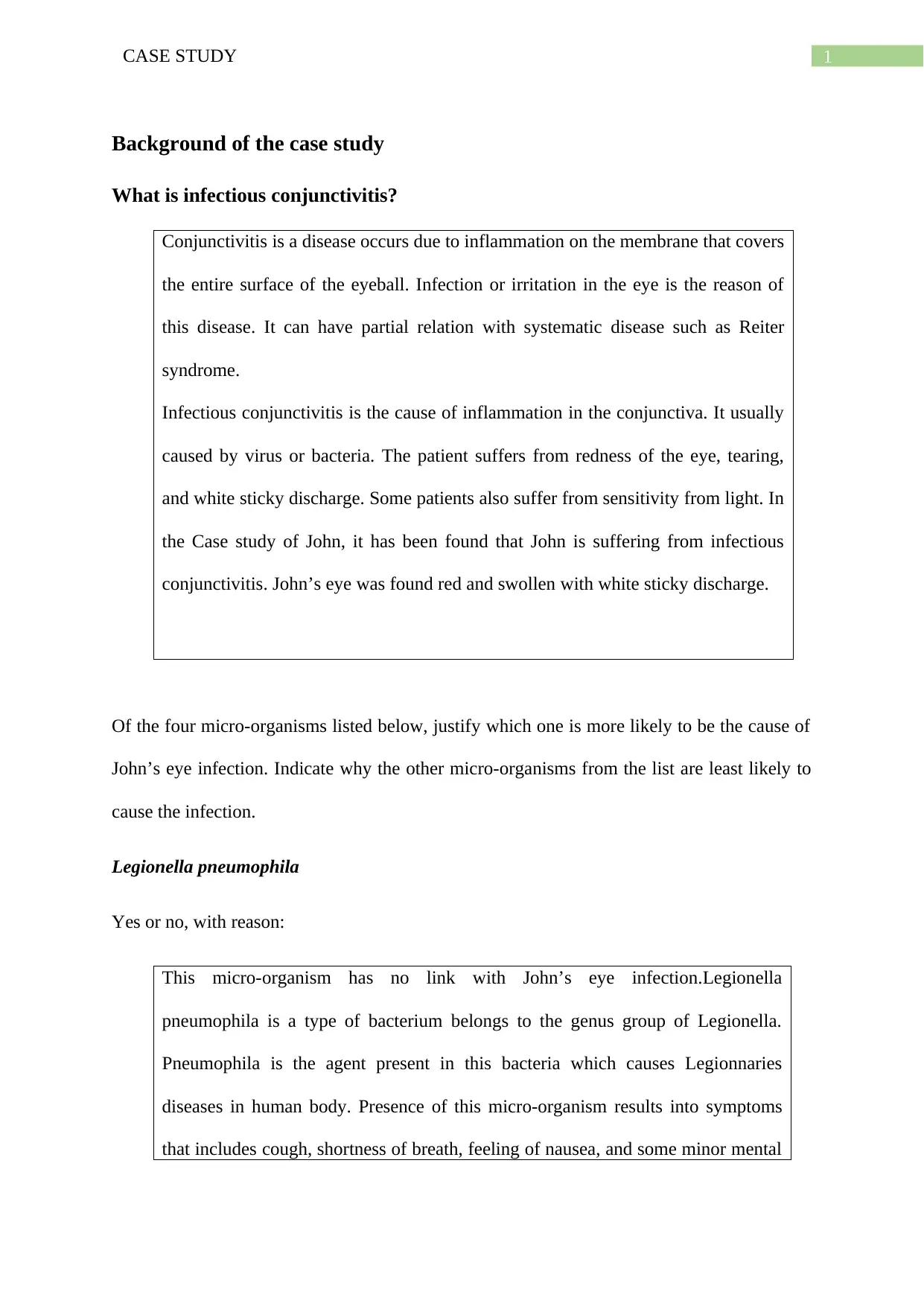
1CASE STUDY
Background of the case study
What is infectious conjunctivitis?
Conjunctivitis is a disease occurs due to inflammation on the membrane that covers
the entire surface of the eyeball. Infection or irritation in the eye is the reason of
this disease. It can have partial relation with systematic disease such as Reiter
syndrome.
Infectious conjunctivitis is the cause of inflammation in the conjunctiva. It usually
caused by virus or bacteria. The patient suffers from redness of the eye, tearing,
and white sticky discharge. Some patients also suffer from sensitivity from light. In
the Case study of John, it has been found that John is suffering from infectious
conjunctivitis. John’s eye was found red and swollen with white sticky discharge.
Of the four micro-organisms listed below, justify which one is more likely to be the cause of
John’s eye infection. Indicate why the other micro-organisms from the list are least likely to
cause the infection.
Legionella pneumophila
Yes or no, with reason:
This micro-organism has no link with John’s eye infection.Legionella
pneumophila is a type of bacterium belongs to the genus group of Legionella.
Pneumophila is the agent present in this bacteria which causes Legionnaries
diseases in human body. Presence of this micro-organism results into symptoms
that includes cough, shortness of breath, feeling of nausea, and some minor mental
Background of the case study
What is infectious conjunctivitis?
Conjunctivitis is a disease occurs due to inflammation on the membrane that covers
the entire surface of the eyeball. Infection or irritation in the eye is the reason of
this disease. It can have partial relation with systematic disease such as Reiter
syndrome.
Infectious conjunctivitis is the cause of inflammation in the conjunctiva. It usually
caused by virus or bacteria. The patient suffers from redness of the eye, tearing,
and white sticky discharge. Some patients also suffer from sensitivity from light. In
the Case study of John, it has been found that John is suffering from infectious
conjunctivitis. John’s eye was found red and swollen with white sticky discharge.
Of the four micro-organisms listed below, justify which one is more likely to be the cause of
John’s eye infection. Indicate why the other micro-organisms from the list are least likely to
cause the infection.
Legionella pneumophila
Yes or no, with reason:
This micro-organism has no link with John’s eye infection.Legionella
pneumophila is a type of bacterium belongs to the genus group of Legionella.
Pneumophila is the agent present in this bacteria which causes Legionnaries
diseases in human body. Presence of this micro-organism results into symptoms
that includes cough, shortness of breath, feeling of nausea, and some minor mental
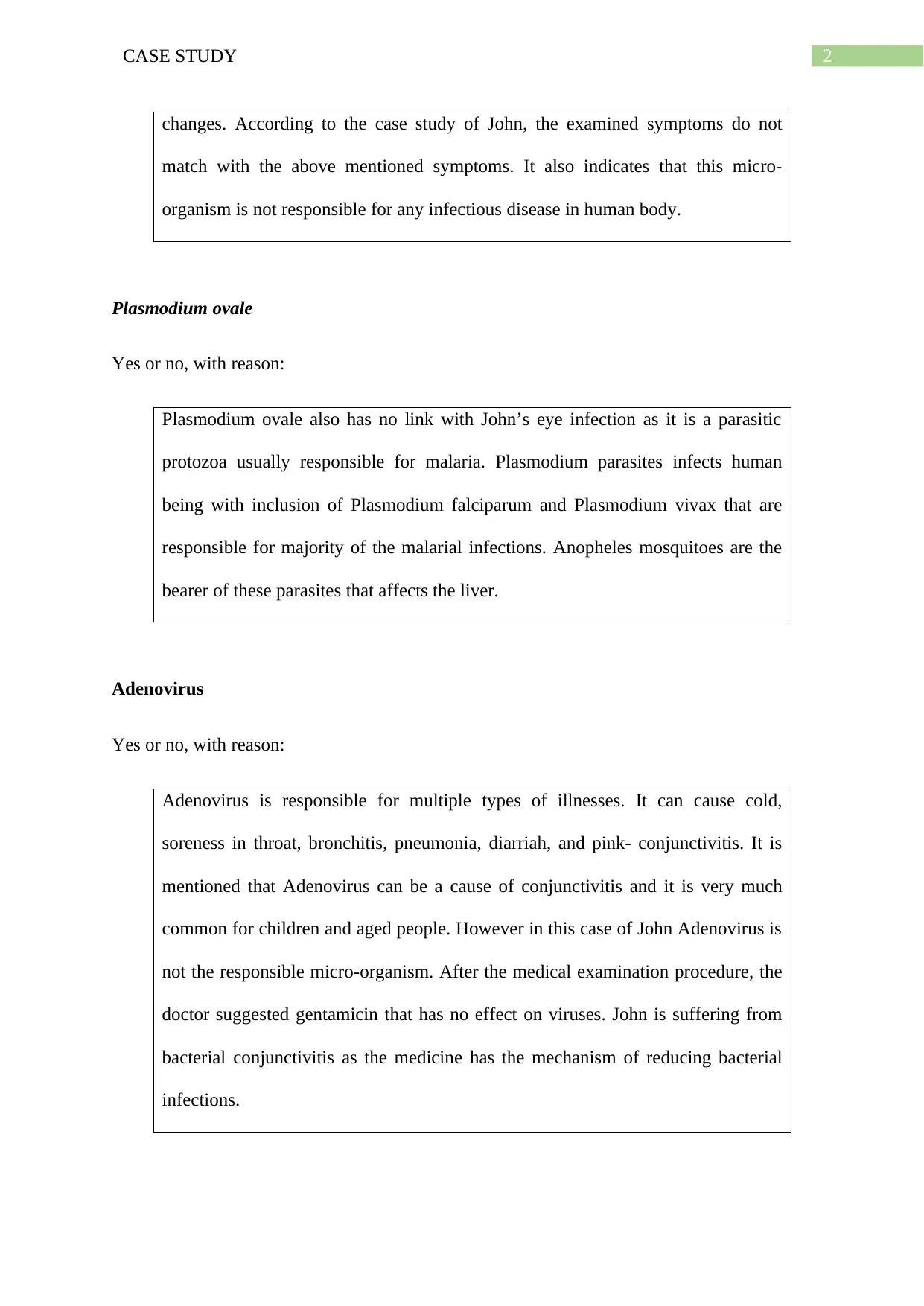
2CASE STUDY
changes. According to the case study of John, the examined symptoms do not
match with the above mentioned symptoms. It also indicates that this micro-
organism is not responsible for any infectious disease in human body.
Plasmodium ovale
Yes or no, with reason:
Plasmodium ovale also has no link with John’s eye infection as it is a parasitic
protozoa usually responsible for malaria. Plasmodium parasites infects human
being with inclusion of Plasmodium falciparum and Plasmodium vivax that are
responsible for majority of the malarial infections. Anopheles mosquitoes are the
bearer of these parasites that affects the liver.
Adenovirus
Yes or no, with reason:
Adenovirus is responsible for multiple types of illnesses. It can cause cold,
soreness in throat, bronchitis, pneumonia, diarriah, and pink- conjunctivitis. It is
mentioned that Adenovirus can be a cause of conjunctivitis and it is very much
common for children and aged people. However in this case of John Adenovirus is
not the responsible micro-organism. After the medical examination procedure, the
doctor suggested gentamicin that has no effect on viruses. John is suffering from
bacterial conjunctivitis as the medicine has the mechanism of reducing bacterial
infections.
changes. According to the case study of John, the examined symptoms do not
match with the above mentioned symptoms. It also indicates that this micro-
organism is not responsible for any infectious disease in human body.
Plasmodium ovale
Yes or no, with reason:
Plasmodium ovale also has no link with John’s eye infection as it is a parasitic
protozoa usually responsible for malaria. Plasmodium parasites infects human
being with inclusion of Plasmodium falciparum and Plasmodium vivax that are
responsible for majority of the malarial infections. Anopheles mosquitoes are the
bearer of these parasites that affects the liver.
Adenovirus
Yes or no, with reason:
Adenovirus is responsible for multiple types of illnesses. It can cause cold,
soreness in throat, bronchitis, pneumonia, diarriah, and pink- conjunctivitis. It is
mentioned that Adenovirus can be a cause of conjunctivitis and it is very much
common for children and aged people. However in this case of John Adenovirus is
not the responsible micro-organism. After the medical examination procedure, the
doctor suggested gentamicin that has no effect on viruses. John is suffering from
bacterial conjunctivitis as the medicine has the mechanism of reducing bacterial
infections.
⊘ This is a preview!⊘
Do you want full access?
Subscribe today to unlock all pages.

Trusted by 1+ million students worldwide
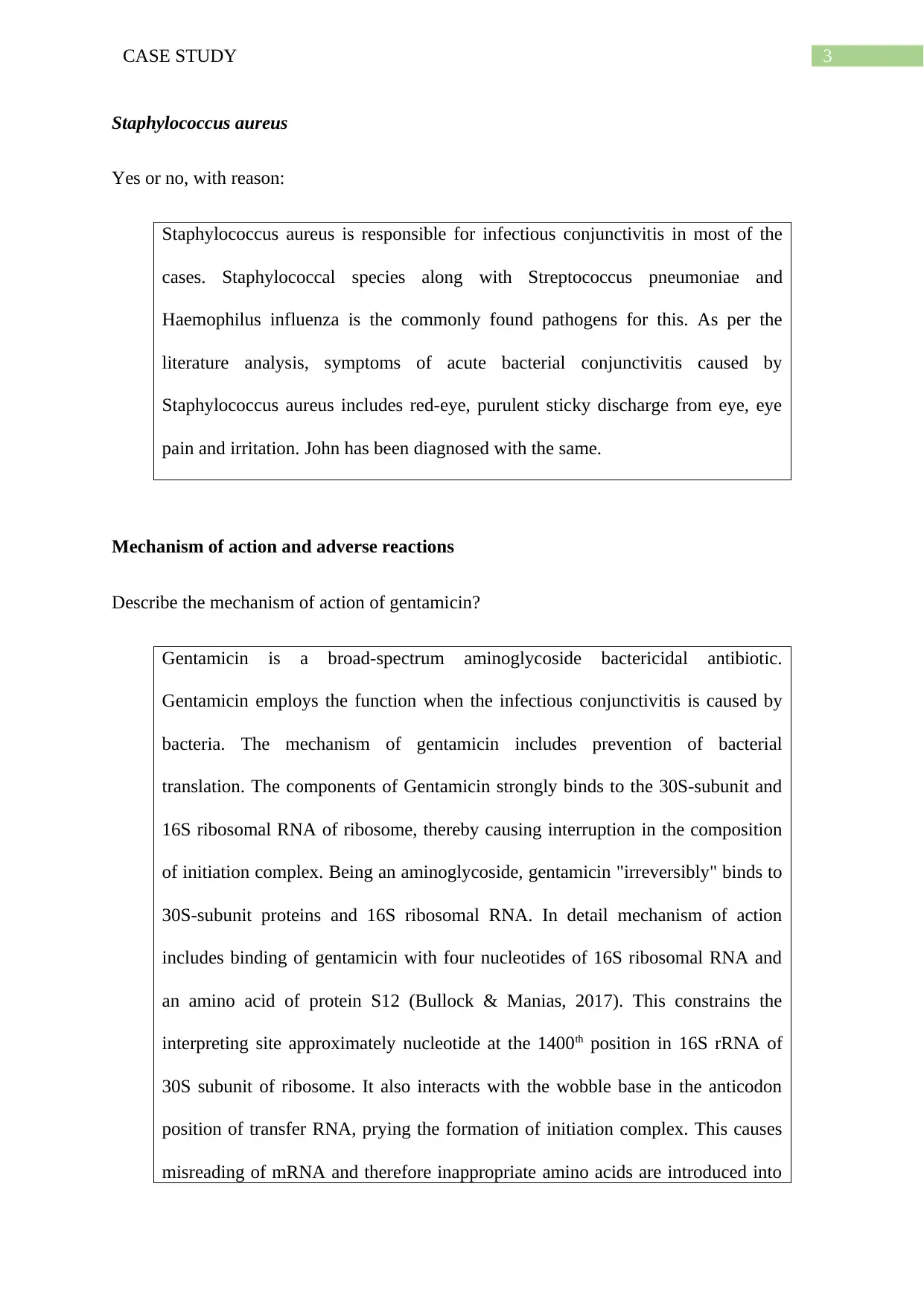
3CASE STUDY
Staphylococcus aureus
Yes or no, with reason:
Staphylococcus aureus is responsible for infectious conjunctivitis in most of the
cases. Staphylococcal species along with Streptococcus pneumoniae and
Haemophilus influenza is the commonly found pathogens for this. As per the
literature analysis, symptoms of acute bacterial conjunctivitis caused by
Staphylococcus aureus includes red-eye, purulent sticky discharge from eye, eye
pain and irritation. John has been diagnosed with the same.
Mechanism of action and adverse reactions
Describe the mechanism of action of gentamicin?
Gentamicin is a broad-spectrum aminoglycoside bactericidal antibiotic.
Gentamicin employs the function when the infectious conjunctivitis is caused by
bacteria. The mechanism of gentamicin includes prevention of bacterial
translation. The components of Gentamicin strongly binds to the 30S-subunit and
16S ribosomal RNA of ribosome, thereby causing interruption in the composition
of initiation complex. Being an aminoglycoside, gentamicin "irreversibly" binds to
30S-subunit proteins and 16S ribosomal RNA. In detail mechanism of action
includes binding of gentamicin with four nucleotides of 16S ribosomal RNA and
an amino acid of protein S12 (Bullock & Manias, 2017). This constrains the
interpreting site approximately nucleotide at the 1400th position in 16S rRNA of
30S subunit of ribosome. It also interacts with the wobble base in the anticodon
position of transfer RNA, prying the formation of initiation complex. This causes
misreading of mRNA and therefore inappropriate amino acids are introduced into
Staphylococcus aureus
Yes or no, with reason:
Staphylococcus aureus is responsible for infectious conjunctivitis in most of the
cases. Staphylococcal species along with Streptococcus pneumoniae and
Haemophilus influenza is the commonly found pathogens for this. As per the
literature analysis, symptoms of acute bacterial conjunctivitis caused by
Staphylococcus aureus includes red-eye, purulent sticky discharge from eye, eye
pain and irritation. John has been diagnosed with the same.
Mechanism of action and adverse reactions
Describe the mechanism of action of gentamicin?
Gentamicin is a broad-spectrum aminoglycoside bactericidal antibiotic.
Gentamicin employs the function when the infectious conjunctivitis is caused by
bacteria. The mechanism of gentamicin includes prevention of bacterial
translation. The components of Gentamicin strongly binds to the 30S-subunit and
16S ribosomal RNA of ribosome, thereby causing interruption in the composition
of initiation complex. Being an aminoglycoside, gentamicin "irreversibly" binds to
30S-subunit proteins and 16S ribosomal RNA. In detail mechanism of action
includes binding of gentamicin with four nucleotides of 16S ribosomal RNA and
an amino acid of protein S12 (Bullock & Manias, 2017). This constrains the
interpreting site approximately nucleotide at the 1400th position in 16S rRNA of
30S subunit of ribosome. It also interacts with the wobble base in the anticodon
position of transfer RNA, prying the formation of initiation complex. This causes
misreading of mRNA and therefore inappropriate amino acids are introduced into
Paraphrase This Document
Need a fresh take? Get an instant paraphrase of this document with our AI Paraphraser
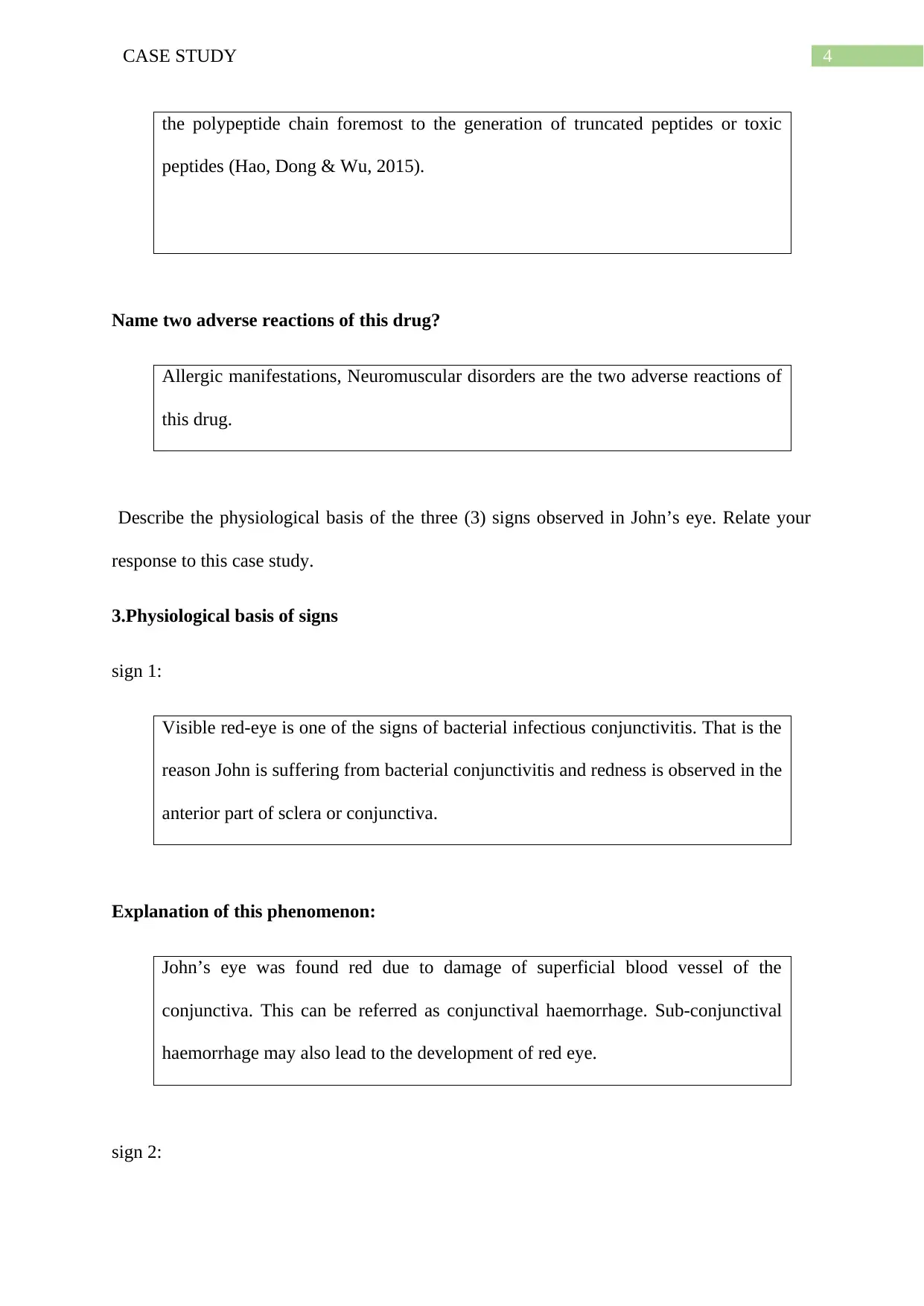
4CASE STUDY
the polypeptide chain foremost to the generation of truncated peptides or toxic
peptides (Hao, Dong & Wu, 2015).
Name two adverse reactions of this drug?
Allergic manifestations, Neuromuscular disorders are the two adverse reactions of
this drug.
Describe the physiological basis of the three (3) signs observed in John’s eye. Relate your
response to this case study.
3.Physiological basis of signs
sign 1:
Visible red-eye is one of the signs of bacterial infectious conjunctivitis. That is the
reason John is suffering from bacterial conjunctivitis and redness is observed in the
anterior part of sclera or conjunctiva.
Explanation of this phenomenon:
John’s eye was found red due to damage of superficial blood vessel of the
conjunctiva. This can be referred as conjunctival haemorrhage. Sub-conjunctival
haemorrhage may also lead to the development of red eye.
sign 2:
the polypeptide chain foremost to the generation of truncated peptides or toxic
peptides (Hao, Dong & Wu, 2015).
Name two adverse reactions of this drug?
Allergic manifestations, Neuromuscular disorders are the two adverse reactions of
this drug.
Describe the physiological basis of the three (3) signs observed in John’s eye. Relate your
response to this case study.
3.Physiological basis of signs
sign 1:
Visible red-eye is one of the signs of bacterial infectious conjunctivitis. That is the
reason John is suffering from bacterial conjunctivitis and redness is observed in the
anterior part of sclera or conjunctiva.
Explanation of this phenomenon:
John’s eye was found red due to damage of superficial blood vessel of the
conjunctiva. This can be referred as conjunctival haemorrhage. Sub-conjunctival
haemorrhage may also lead to the development of red eye.
sign 2:
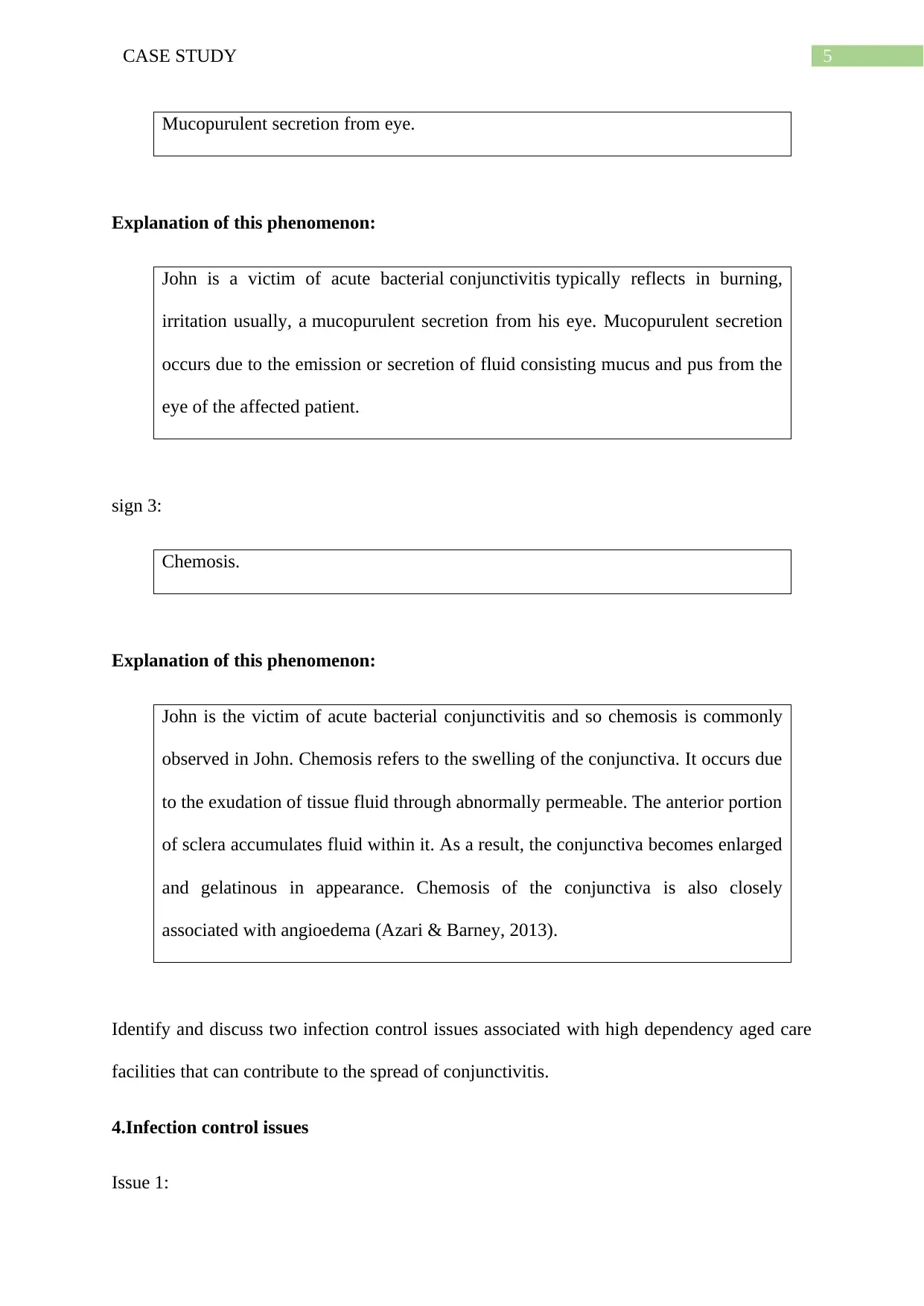
5CASE STUDY
Mucopurulent secretion from eye.
Explanation of this phenomenon:
John is a victim of acute bacterial conjunctivitis typically reflects in burning,
irritation usually, a mucopurulent secretion from his eye. Mucopurulent secretion
occurs due to the emission or secretion of fluid consisting mucus and pus from the
eye of the affected patient.
sign 3:
Chemosis.
Explanation of this phenomenon:
John is the victim of acute bacterial conjunctivitis and so chemosis is commonly
observed in John. Chemosis refers to the swelling of the conjunctiva. It occurs due
to the exudation of tissue fluid through abnormally permeable. The anterior portion
of sclera accumulates fluid within it. As a result, the conjunctiva becomes enlarged
and gelatinous in appearance. Chemosis of the conjunctiva is also closely
associated with angioedema (Azari & Barney, 2013).
Identify and discuss two infection control issues associated with high dependency aged care
facilities that can contribute to the spread of conjunctivitis.
4.Infection control issues
Issue 1:
Mucopurulent secretion from eye.
Explanation of this phenomenon:
John is a victim of acute bacterial conjunctivitis typically reflects in burning,
irritation usually, a mucopurulent secretion from his eye. Mucopurulent secretion
occurs due to the emission or secretion of fluid consisting mucus and pus from the
eye of the affected patient.
sign 3:
Chemosis.
Explanation of this phenomenon:
John is the victim of acute bacterial conjunctivitis and so chemosis is commonly
observed in John. Chemosis refers to the swelling of the conjunctiva. It occurs due
to the exudation of tissue fluid through abnormally permeable. The anterior portion
of sclera accumulates fluid within it. As a result, the conjunctiva becomes enlarged
and gelatinous in appearance. Chemosis of the conjunctiva is also closely
associated with angioedema (Azari & Barney, 2013).
Identify and discuss two infection control issues associated with high dependency aged care
facilities that can contribute to the spread of conjunctivitis.
4.Infection control issues
Issue 1:
⊘ This is a preview!⊘
Do you want full access?
Subscribe today to unlock all pages.

Trusted by 1+ million students worldwide
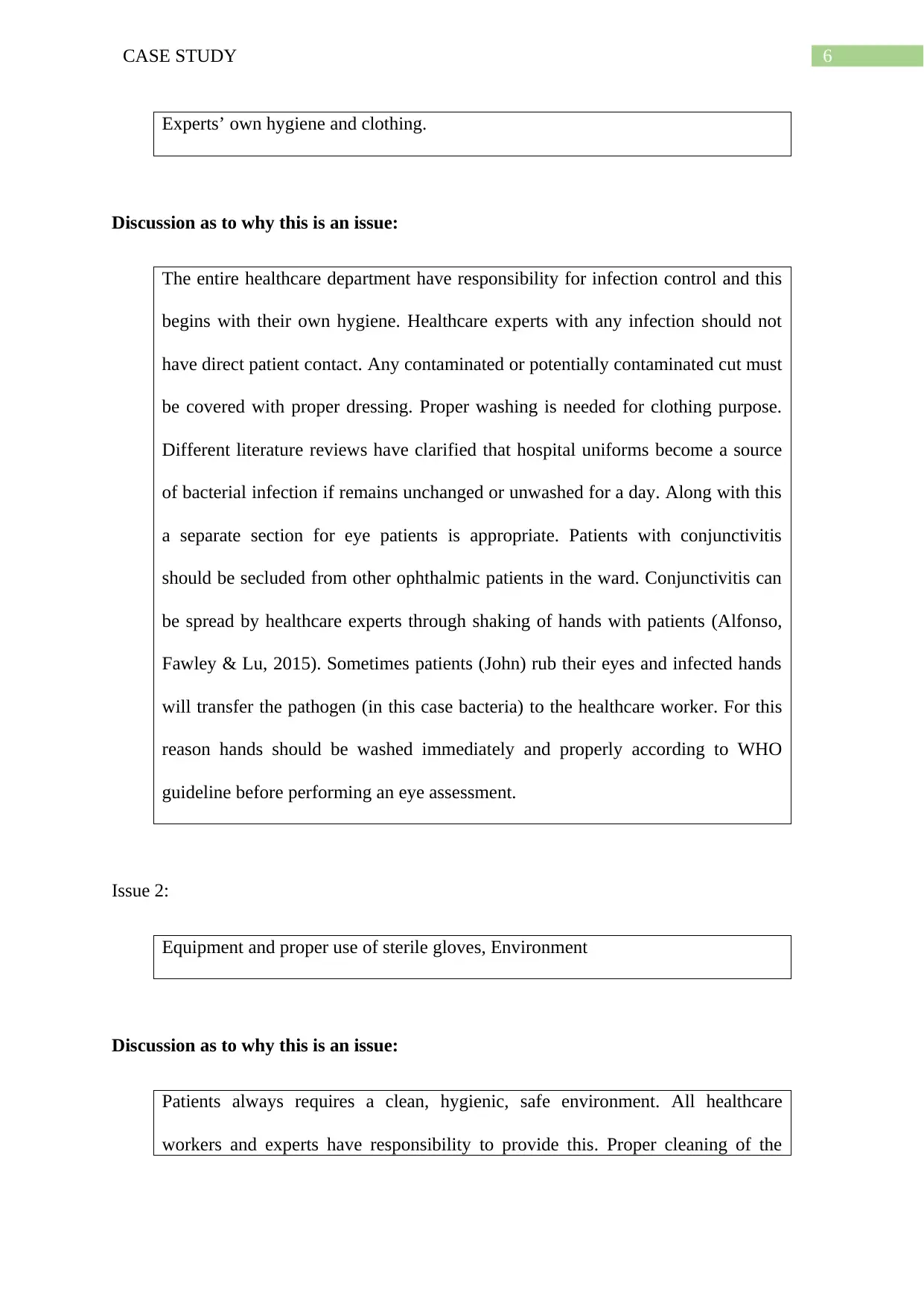
6CASE STUDY
Experts’ own hygiene and clothing.
Discussion as to why this is an issue:
The entire healthcare department have responsibility for infection control and this
begins with their own hygiene. Healthcare experts with any infection should not
have direct patient contact. Any contaminated or potentially contaminated cut must
be covered with proper dressing. Proper washing is needed for clothing purpose.
Different literature reviews have clarified that hospital uniforms become a source
of bacterial infection if remains unchanged or unwashed for a day. Along with this
a separate section for eye patients is appropriate. Patients with conjunctivitis
should be secluded from other ophthalmic patients in the ward. Conjunctivitis can
be spread by healthcare experts through shaking of hands with patients (Alfonso,
Fawley & Lu, 2015). Sometimes patients (John) rub their eyes and infected hands
will transfer the pathogen (in this case bacteria) to the healthcare worker. For this
reason hands should be washed immediately and properly according to WHO
guideline before performing an eye assessment.
Issue 2:
Equipment and proper use of sterile gloves, Environment
Discussion as to why this is an issue:
Patients always requires a clean, hygienic, safe environment. All healthcare
workers and experts have responsibility to provide this. Proper cleaning of the
Experts’ own hygiene and clothing.
Discussion as to why this is an issue:
The entire healthcare department have responsibility for infection control and this
begins with their own hygiene. Healthcare experts with any infection should not
have direct patient contact. Any contaminated or potentially contaminated cut must
be covered with proper dressing. Proper washing is needed for clothing purpose.
Different literature reviews have clarified that hospital uniforms become a source
of bacterial infection if remains unchanged or unwashed for a day. Along with this
a separate section for eye patients is appropriate. Patients with conjunctivitis
should be secluded from other ophthalmic patients in the ward. Conjunctivitis can
be spread by healthcare experts through shaking of hands with patients (Alfonso,
Fawley & Lu, 2015). Sometimes patients (John) rub their eyes and infected hands
will transfer the pathogen (in this case bacteria) to the healthcare worker. For this
reason hands should be washed immediately and properly according to WHO
guideline before performing an eye assessment.
Issue 2:
Equipment and proper use of sterile gloves, Environment
Discussion as to why this is an issue:
Patients always requires a clean, hygienic, safe environment. All healthcare
workers and experts have responsibility to provide this. Proper cleaning of the
Paraphrase This Document
Need a fresh take? Get an instant paraphrase of this document with our AI Paraphraser
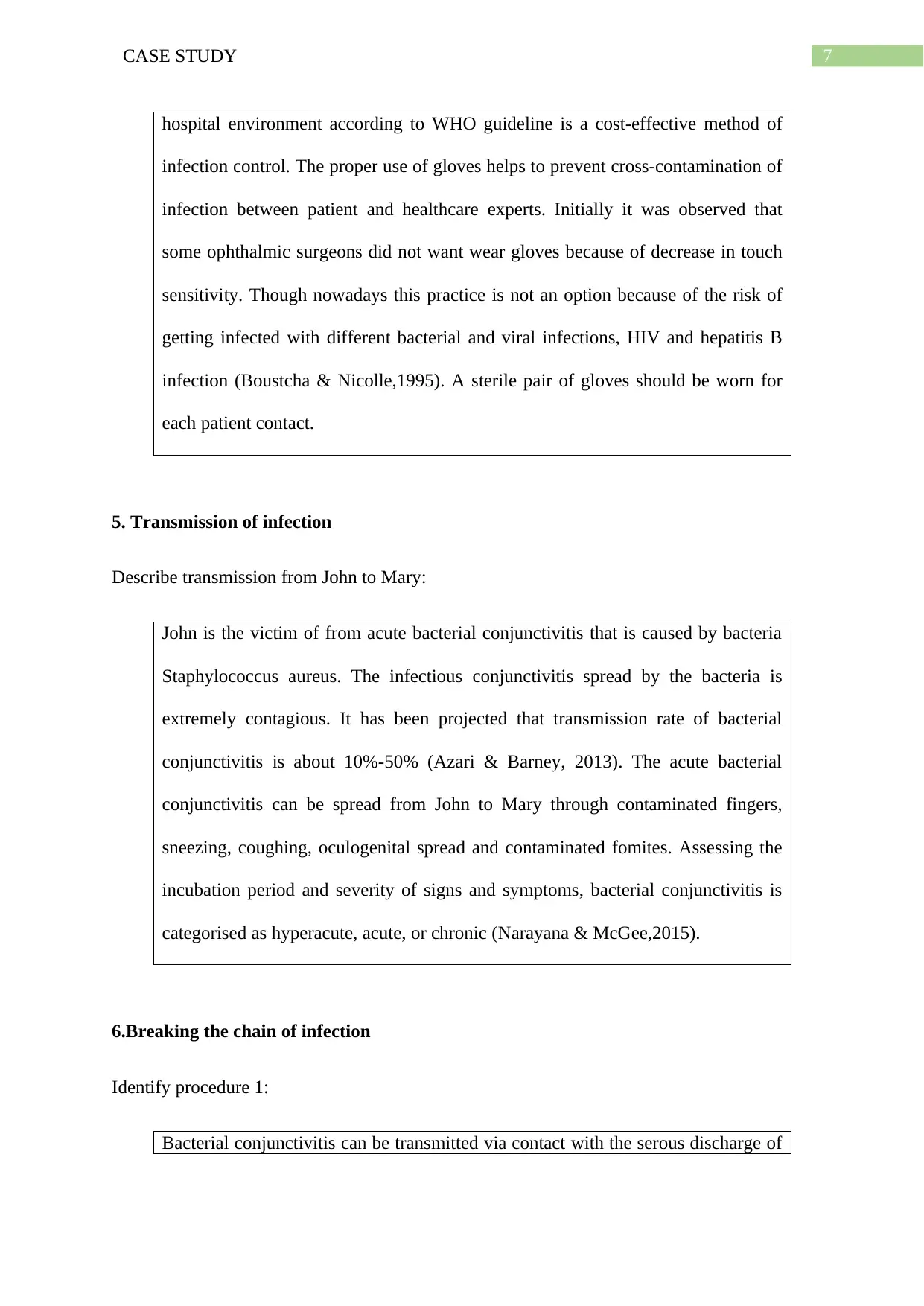
7CASE STUDY
hospital environment according to WHO guideline is a cost-effective method of
infection control. The proper use of gloves helps to prevent cross-contamination of
infection between patient and healthcare experts. Initially it was observed that
some ophthalmic surgeons did not want wear gloves because of decrease in touch
sensitivity. Though nowadays this practice is not an option because of the risk of
getting infected with different bacterial and viral infections, HIV and hepatitis B
infection (Boustcha & Nicolle,1995). A sterile pair of gloves should be worn for
each patient contact.
5. Transmission of infection
Describe transmission from John to Mary:
John is the victim of from acute bacterial conjunctivitis that is caused by bacteria
Staphylococcus aureus. The infectious conjunctivitis spread by the bacteria is
extremely contagious. It has been projected that transmission rate of bacterial
conjunctivitis is about 10%-50% (Azari & Barney, 2013). The acute bacterial
conjunctivitis can be spread from John to Mary through contaminated fingers,
sneezing, coughing, oculogenital spread and contaminated fomites. Assessing the
incubation period and severity of signs and symptoms, bacterial conjunctivitis is
categorised as hyperacute, acute, or chronic (Narayana & McGee,2015).
6.Breaking the chain of infection
Identify procedure 1:
Bacterial conjunctivitis can be transmitted via contact with the serous discharge of
hospital environment according to WHO guideline is a cost-effective method of
infection control. The proper use of gloves helps to prevent cross-contamination of
infection between patient and healthcare experts. Initially it was observed that
some ophthalmic surgeons did not want wear gloves because of decrease in touch
sensitivity. Though nowadays this practice is not an option because of the risk of
getting infected with different bacterial and viral infections, HIV and hepatitis B
infection (Boustcha & Nicolle,1995). A sterile pair of gloves should be worn for
each patient contact.
5. Transmission of infection
Describe transmission from John to Mary:
John is the victim of from acute bacterial conjunctivitis that is caused by bacteria
Staphylococcus aureus. The infectious conjunctivitis spread by the bacteria is
extremely contagious. It has been projected that transmission rate of bacterial
conjunctivitis is about 10%-50% (Azari & Barney, 2013). The acute bacterial
conjunctivitis can be spread from John to Mary through contaminated fingers,
sneezing, coughing, oculogenital spread and contaminated fomites. Assessing the
incubation period and severity of signs and symptoms, bacterial conjunctivitis is
categorised as hyperacute, acute, or chronic (Narayana & McGee,2015).
6.Breaking the chain of infection
Identify procedure 1:
Bacterial conjunctivitis can be transmitted via contact with the serous discharge of
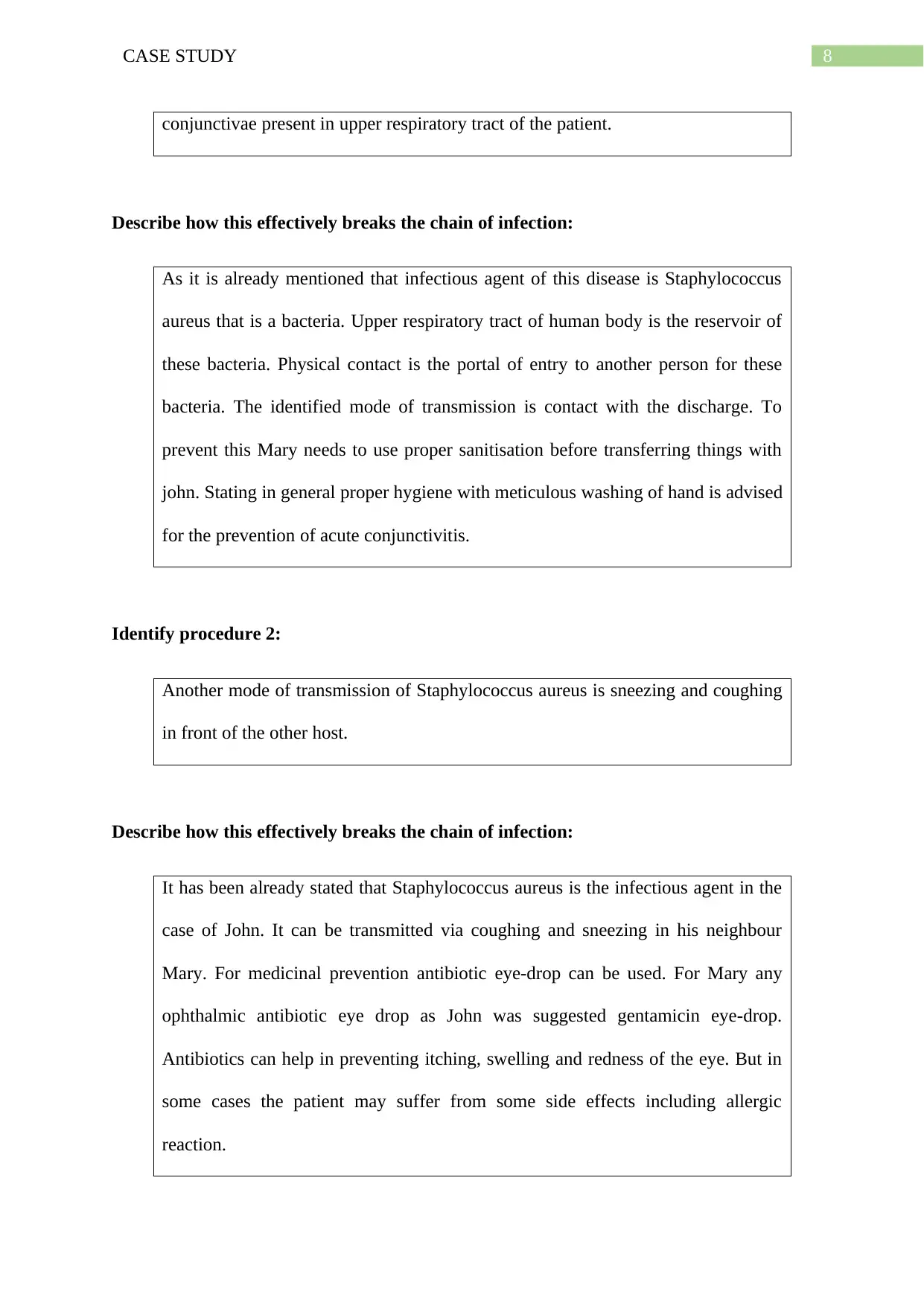
8CASE STUDY
conjunctivae present in upper respiratory tract of the patient.
Describe how this effectively breaks the chain of infection:
As it is already mentioned that infectious agent of this disease is Staphylococcus
aureus that is a bacteria. Upper respiratory tract of human body is the reservoir of
these bacteria. Physical contact is the portal of entry to another person for these
bacteria. The identified mode of transmission is contact with the discharge. To
prevent this Mary needs to use proper sanitisation before transferring things with
john. Stating in general proper hygiene with meticulous washing of hand is advised
for the prevention of acute conjunctivitis.
Identify procedure 2:
Another mode of transmission of Staphylococcus aureus is sneezing and coughing
in front of the other host.
Describe how this effectively breaks the chain of infection:
It has been already stated that Staphylococcus aureus is the infectious agent in the
case of John. It can be transmitted via coughing and sneezing in his neighbour
Mary. For medicinal prevention antibiotic eye-drop can be used. For Mary any
ophthalmic antibiotic eye drop as John was suggested gentamicin eye-drop.
Antibiotics can help in preventing itching, swelling and redness of the eye. But in
some cases the patient may suffer from some side effects including allergic
reaction.
conjunctivae present in upper respiratory tract of the patient.
Describe how this effectively breaks the chain of infection:
As it is already mentioned that infectious agent of this disease is Staphylococcus
aureus that is a bacteria. Upper respiratory tract of human body is the reservoir of
these bacteria. Physical contact is the portal of entry to another person for these
bacteria. The identified mode of transmission is contact with the discharge. To
prevent this Mary needs to use proper sanitisation before transferring things with
john. Stating in general proper hygiene with meticulous washing of hand is advised
for the prevention of acute conjunctivitis.
Identify procedure 2:
Another mode of transmission of Staphylococcus aureus is sneezing and coughing
in front of the other host.
Describe how this effectively breaks the chain of infection:
It has been already stated that Staphylococcus aureus is the infectious agent in the
case of John. It can be transmitted via coughing and sneezing in his neighbour
Mary. For medicinal prevention antibiotic eye-drop can be used. For Mary any
ophthalmic antibiotic eye drop as John was suggested gentamicin eye-drop.
Antibiotics can help in preventing itching, swelling and redness of the eye. But in
some cases the patient may suffer from some side effects including allergic
reaction.
⊘ This is a preview!⊘
Do you want full access?
Subscribe today to unlock all pages.

Trusted by 1+ million students worldwide

9CASE STUDY
Paraphrase This Document
Need a fresh take? Get an instant paraphrase of this document with our AI Paraphraser
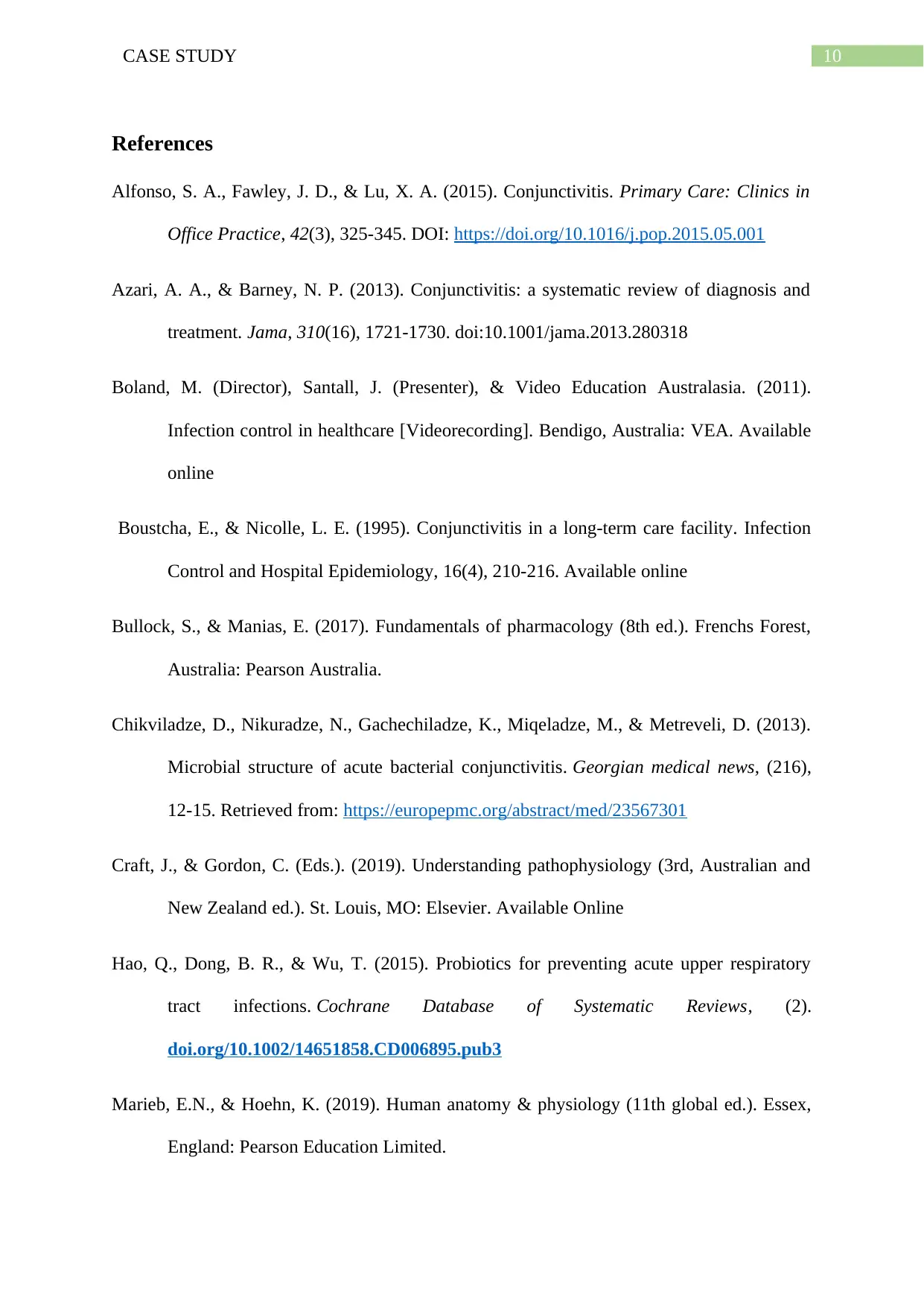
10CASE STUDY
References
Alfonso, S. A., Fawley, J. D., & Lu, X. A. (2015). Conjunctivitis. Primary Care: Clinics in
Office Practice, 42(3), 325-345. DOI: https://doi.org/10.1016/j.pop.2015.05.001
Azari, A. A., & Barney, N. P. (2013). Conjunctivitis: a systematic review of diagnosis and
treatment. Jama, 310(16), 1721-1730. doi:10.1001/jama.2013.280318
Boland, M. (Director), Santall, J. (Presenter), & Video Education Australasia. (2011).
Infection control in healthcare [Videorecording]. Bendigo, Australia: VEA. Available
online
Boustcha, E., & Nicolle, L. E. (1995). Conjunctivitis in a long-term care facility. Infection
Control and Hospital Epidemiology, 16(4), 210-216. Available online
Bullock, S., & Manias, E. (2017). Fundamentals of pharmacology (8th ed.). Frenchs Forest,
Australia: Pearson Australia.
Chikviladze, D., Nikuradze, N., Gachechiladze, K., Miqeladze, M., & Metreveli, D. (2013).
Microbial structure of acute bacterial conjunctivitis. Georgian medical news, (216),
12-15. Retrieved from: https://europepmc.org/abstract/med/23567301
Craft, J., & Gordon, C. (Eds.). (2019). Understanding pathophysiology (3rd, Australian and
New Zealand ed.). St. Louis, MO: Elsevier. Available Online
Hao, Q., Dong, B. R., & Wu, T. (2015). Probiotics for preventing acute upper respiratory
tract infections. Cochrane Database of Systematic Reviews, (2).
doi.org/10.1002/14651858.CD006895.pub3
Marieb, E.N., & Hoehn, K. (2019). Human anatomy & physiology (11th global ed.). Essex,
England: Pearson Education Limited.
References
Alfonso, S. A., Fawley, J. D., & Lu, X. A. (2015). Conjunctivitis. Primary Care: Clinics in
Office Practice, 42(3), 325-345. DOI: https://doi.org/10.1016/j.pop.2015.05.001
Azari, A. A., & Barney, N. P. (2013). Conjunctivitis: a systematic review of diagnosis and
treatment. Jama, 310(16), 1721-1730. doi:10.1001/jama.2013.280318
Boland, M. (Director), Santall, J. (Presenter), & Video Education Australasia. (2011).
Infection control in healthcare [Videorecording]. Bendigo, Australia: VEA. Available
online
Boustcha, E., & Nicolle, L. E. (1995). Conjunctivitis in a long-term care facility. Infection
Control and Hospital Epidemiology, 16(4), 210-216. Available online
Bullock, S., & Manias, E. (2017). Fundamentals of pharmacology (8th ed.). Frenchs Forest,
Australia: Pearson Australia.
Chikviladze, D., Nikuradze, N., Gachechiladze, K., Miqeladze, M., & Metreveli, D. (2013).
Microbial structure of acute bacterial conjunctivitis. Georgian medical news, (216),
12-15. Retrieved from: https://europepmc.org/abstract/med/23567301
Craft, J., & Gordon, C. (Eds.). (2019). Understanding pathophysiology (3rd, Australian and
New Zealand ed.). St. Louis, MO: Elsevier. Available Online
Hao, Q., Dong, B. R., & Wu, T. (2015). Probiotics for preventing acute upper respiratory
tract infections. Cochrane Database of Systematic Reviews, (2).
doi.org/10.1002/14651858.CD006895.pub3
Marieb, E.N., & Hoehn, K. (2019). Human anatomy & physiology (11th global ed.). Essex,
England: Pearson Education Limited.

11CASE STUDY
Messmer, E. M. (2015). The pathophysiology, diagnosis, and treatment of dry eye
disease. Deutsches Ärzteblatt International, 112(5), 71. doi: 10.3238/arztebl.2015.0071
Messmer, E. M. (2015). The pathophysiology, diagnosis, and treatment of dry eye
disease. Deutsches Ärzteblatt International, 112(5), 71. doi: 10.3238/arztebl.2015.0071
⊘ This is a preview!⊘
Do you want full access?
Subscribe today to unlock all pages.

Trusted by 1+ million students worldwide
1 out of 12
Related Documents
Your All-in-One AI-Powered Toolkit for Academic Success.
+13062052269
info@desklib.com
Available 24*7 on WhatsApp / Email
![[object Object]](/_next/static/media/star-bottom.7253800d.svg)
Unlock your academic potential
Copyright © 2020–2025 A2Z Services. All Rights Reserved. Developed and managed by ZUCOL.





